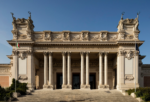II Stile (Mott) – Shinya Watanabe
.jpg)
Lecture di Shinya Watanabe
Comunicato stampa
II.STILE - the nomadic canvas-based artist-run exhibition-space, opens a new venue focusing on talks and storytelling. Depicting one of the most equipped bathroom in New York City offices at the end of 19th century produced by the Mott Iron Work, the Company that designed the legendary pissoir of Marcel Duchamp's, II.STILE (Mott) defines itself as a pre-readymade bathroom that potentially expresses all the various dynamics forming the base of contemporary society.
II.STILE (Mott) functions as a temporary theater in order to generate and present to a public various ideological spectrums of future transformation in the form of lectures and artistic statements.
Paolo Chiasera 2013
Searching for Eurasia
After completing the 3 Months Cross Continental Research Trip
Shinya Watanabe
Independent Curator
Doktorant: Universität der Künste Berlin
Lecturer, University of Applied Sciences, Berlin
This is a report of trans-continental fieldwork by a Berlin based independent curator Shinya Watanabe.
While living in New York City for 7 years and had traveled many countries mainly in Europe and Asia as a back-packer, I have continued my research on art history. In the process, I realized that what is so called “Europe” and “Asia”, or “West” and “East” is mere an imaginary division, and found that both of them shares the same roots, and had been developed by influencing each other.
To think like that, I have been influenced by German Artist Joseph Beuys and Korean artist Nam June Paik’s life long collaborative art project called “Eur-Asia”. Through this project, they tried to overcome the divides of ideology and the modern nation-states which could be also the cause of war, and declared the ideal of “Eur-Asia”, the unity of Europe and Asia as one continental culture.
Even so, I felt a need to know how the continuity of language, religious and culture exist in Eurasia. Therefore, I decided to cross the Eurasian continent without using an airplane, from Berlin to my home country Japan, from July to October 2013.
First, I departed Berlin, and went to Crimean Peninsula of Ukraine where Joseph Beuys’s bomber crashed, and did a research with local Tatars who may saved the life of Joseph Beuys. From the Christian Icon paintings in an old monastery of Georgia, I could feel the influence of mudra hand sign of Hinduism.
On the way of crossing “Silk Road” to Samarkand, I accidentally found the bird funeral site of Zoroastrianism. Then I continued northern “Steppe Road” of Siberia to Irkutsk which Nam June Paik called the “Highway of Eurasia”. There I met Buryats, one of the Mongolian tribe considered to be the roots of Japanese. They believe reincarnation, and consider white swans as their ancestor.
In Mongolia, I discovered and experienced the traditional massage of using fat and felt which Joseph Beuys may be experienced. In Ulaanbaatar, I asked a local shaman to bring down the soul of late Chris Marker, the film director who claimed to be born in Ulaanbaatar.
After visiting China, I visited Nam June Paik Art Center in Seoul by ferry, and returned my home country Japan. In this opportunity, I would like to share the photos and videos which I discovered in this journey.
Isn’t it a cause of war, that all of us living on the same earth do not know each other, and considering others as completely different thing, which cause any suspicion or hostility? Don’t you think that we can abolish the war, if we could consider other people or cultures which you had thought completely different is actually connected to your own?
Now we are facing the end of modernity, and even experiencing the shift of civilization. I believe that the outcome of this fieldwork will be the great common assets of humankind, and will illuminate our future after the end of modernity.



